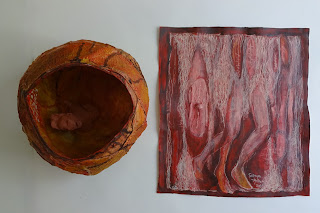One morning I took a bus to Sangri. It is said that "Sangri" is a corruption of "Sainte Croix," which is what the French called the town's monastery. In the entrance of this tiny village of Venetian towers, Byzantine churches and narrow streets, there was a water fountain, like in some old Spanish towns. I washed my face and drank water like if I was doing something that thousand other travelers had done before me throughout the centuries.
After walking around the village and looking at the Mediterranean panoramas and the view of the ruins that the village offers, I took one of the roads just before the entrance of the town. I walked under the sun of the Aegean summer passing ruins, rocks, and olives, that landscape of the Cyclades that I was starting to like.
After a long walk I encountered a small Byzantine church full of frescoes in the interior walls and ceiling. The images were destroyed by the passing of time, but you could still identify the main icons and designs. All the icons were represented with dark skin, like I had noticed in other Byzantine churches.
I am not a very spiritual person, but I could feel that my walk in Sangri was been tr ansformed into a pilgrimage. Somehow after exploring ancient sites I discovered the ephemeral quality of art. I also felt the innate human need of making marks and leaving traces of our existence. In my journey I found something I did not have before, even I am still searching for that object or place that illuminates my understanding of humanity and culture.
ansformed into a pilgrimage. Somehow after exploring ancient sites I discovered the ephemeral quality of art. I also felt the innate human need of making marks and leaving traces of our existence. In my journey I found something I did not have before, even I am still searching for that object or place that illuminates my understanding of humanity and culture.
After walking around the village and looking at the Mediterranean panoramas and the view of the ruins that the village offers, I took one of the roads just before the entrance of the town. I walked under the sun of the Aegean summer passing ruins, rocks, and olives, that landscape of the Cyclades that I was starting to like.
After a long walk I encountered a small Byzantine church full of frescoes in the interior walls and ceiling. The images were destroyed by the passing of time, but you could still identify the main icons and designs. All the icons were represented with dark skin, like I had noticed in other Byzantine churches.
I am not a very spiritual person, but I could feel that my walk in Sangri was been tr

Comments